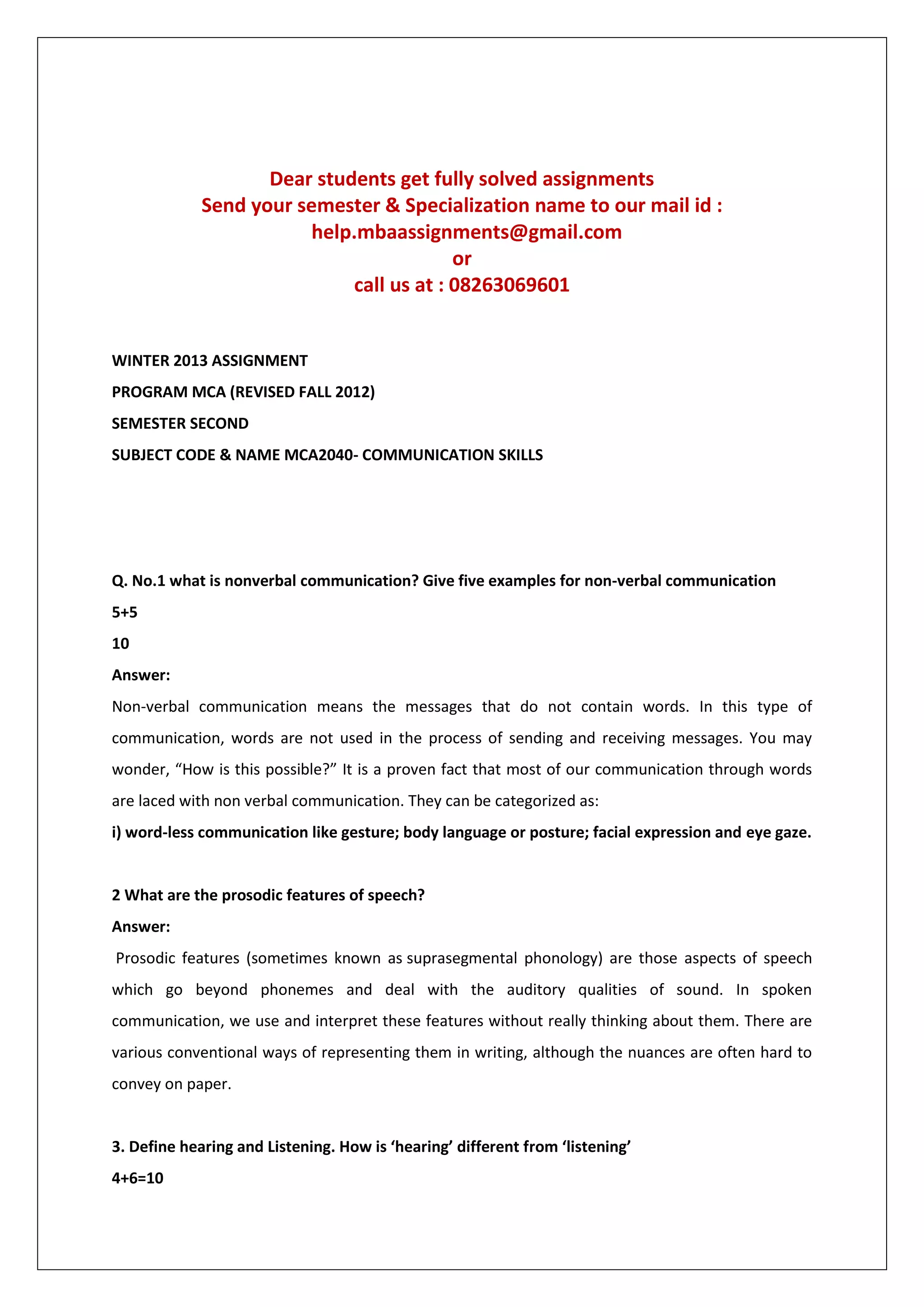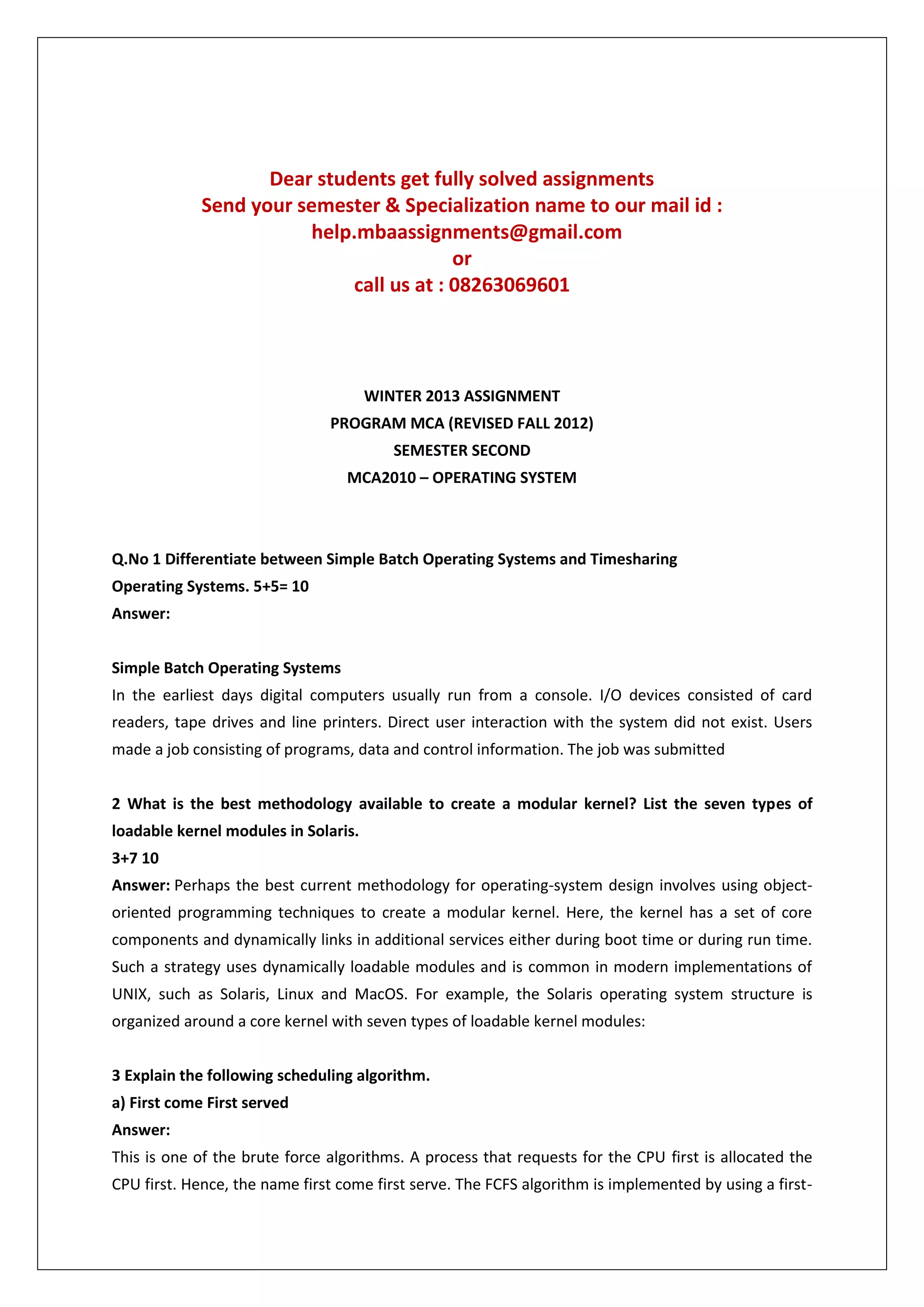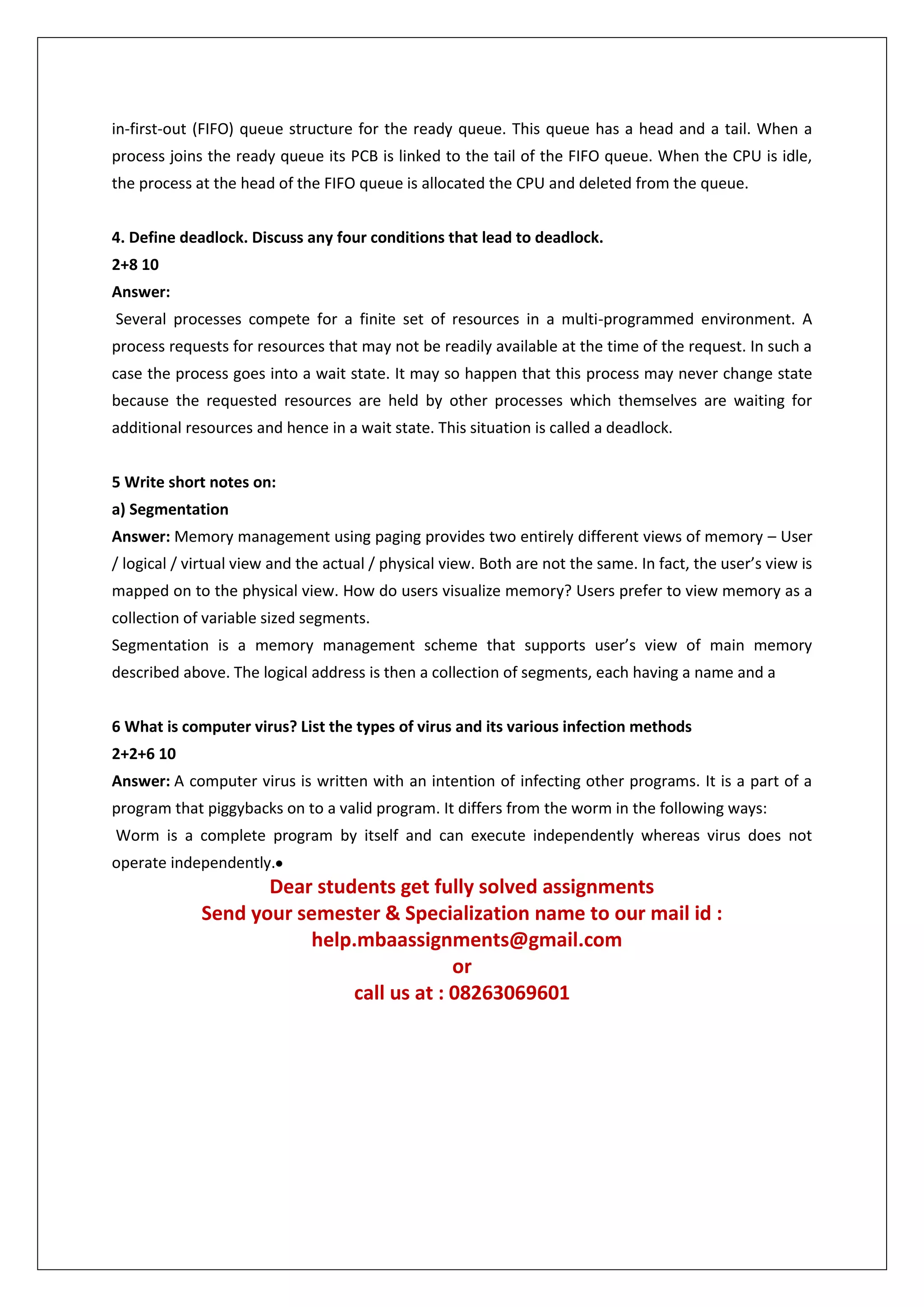This document contains a series of assignment questions and their corresponding answers for a winter 2013 semester MCA program. Topics covered include computer architecture, communication skills, object-oriented programming, advanced data structures, and operating systems, with definitions, explanations, and comparisons related to key concepts in each subject area. Students are encouraged to contact the provided email or phone number for assistance with assignments.
![Dear students get fully solved assignments
Send your semester & Specialization name to our mail id :
help.mbaassignments@gmail.com
or
call us at : 08263069601
WINTER 2013 ASSIGNMENT
PROGRAM MCA (REVISED FALL 2012)
SEMESTER SECOND
SUBJECT CODE & NAME MCA2050- COMPUTER ARCHITECTURE
CREDIT 4
BK ID B1648
Q. No.1 Differentiate between Process and Thread.
[5+5]
Answer:
Concept of process
In operating system terminology, instead of the term ‘program’, the notion of process is used in
connection with execution. It designates a commission or job, or a quantum of work dealt with as an
entity. Consequently, the resources required, such as address space, are typically allocated on a
process basis. Each process has a life cycle, which consists of creation, an execution phase and
termination.
Process creation involves the following four main actions:
2 What are instruction sets? Give the classification of the various instruction sets.
[5+5]
Answer: An instruction set, or instruction set architecture (ISA), is the part of the computer
architecture related to programming, including the native data types, instructions, registers,
addressing modes, memory architecture, interrupt and exception handling, and external I/O. An ISA
includes a specification of the set of opcodes (machine language), and the native commands
implemented by a particular processor.
3 What do you mean by hazards? Explain the types of hazards
[4+6]
Answer:
Hazards are the situations that stop the next instruction in the instruction stream from being
executed during its designated clock cycle.
Hazards reduce the performance from the ideal speedup gained by pipelining. In general, there are
three major categories of hazards that can affect normal operation of a pipeline.](https://image.slidesharecdn.com/mcawinter20132ndsem-140225004935-phpapp02/75/Mca-winter-2013-2nd-sem-1-2048.jpg)
![1. Structural hazards (also called resource conflicts): They occur from resource conflicts when the
hardware cannot support all possible combinations of instructions in simultaneous overlapped
execution. These are caused by multiple accesses to memory performed by segments. In most cases
this problem can be resolved by using separate instruction and data memories.
2. Data hazards (also called data dependency): They occur when an instruction depends on the
result of
4 What do you understand by parallel processing? Describe Pipeline Processing.
[3+7]
Answer: Parallel processing is basic part of our everyday life. The concept of parallel processing is so
natural in our life that we use it without even realising. When we face some crisis, we take help from
others and involve them to solve it more easily. This cooperation of using two or more helpers to
make easy the solution of some problem may be termed parallel processing. The aim of parallel
processing is therefore to solve a particular problem more rapidly, or to enable the solution of a
particular problem that would otherwise be not solvable by one person. The principles of parallel
processing are, however, not recent, as evidence suggests that the computational devices used over
2000 years ago also used this.
5 Differentiate between unconditional and conditional branch.
[5+5]
Answer:
Unconditional Branch
This type of branch is considered as the simplest one. It is used to transfer control to a particular
target. Let us discuss an example as follows:
branch target
Target address specification can be performed in any of the following ways:
6 Write short notes on:
a) Vector Length
b) Vector Stride
[5+5]
Answer: Vector length
Particularly, we have two cases in our hands:
One in which the vector size is less than the vector register size, and
The second in which the vector size is larger than the vector register size.
Let’s observe the easier of these two problems.
Handling smaller vectors: In case the vector size is less than 64, we have to permit the system to
be aware that it should not function on all the 64 elements in the vector registers. This can be
simply done](https://image.slidesharecdn.com/mcawinter20132ndsem-140225004935-phpapp02/75/Mca-winter-2013-2nd-sem-2-2048.jpg)

![Answer:
Hearing is a passive process. It is merely the detection of sounds around us. Normally, we come
across ‘hearing’ in certain situations.
E.g.: When your lecturer reprimands you for some of your shortcomings, you just hear it without
paying much attention.
Listening: It is an active process. It involves the conscious desire to determine the meaning of what
is
Dear students get fully solved assignments
Send your semester & Specialization name to our mail id :
help.mbaassignments@gmail.com
or
call us at : 08263069601
WINTER 2013 ASSIGNMENT
PROGRAM MCA (REVISED FALL 2012)
SEMESTER SECOND
SUBJECT CODE & NAME MCA2030- OBJECT ORIENTED PROGRAMMING – C++
Q. No.1 Differentiate between Objects and Classes
[5+5]
Answer: An Object is a program representation of some real-world thing (i.e person, place or an
event). Objects can have both attributes(data) and behaviours (functions or methods). Attributes
describe the object with respect to certain parameters and Behaviour or functions describe the
functionality of the object.
According to Pressman, Objects can be any one of the following:
a) External entities b) Things c) Occurrences or events d) Roles e) Organisational units f) Places g)
Data Structures
2 Explain about friend functions and friend classes in detail
Answer:
Friend Functions](https://image.slidesharecdn.com/mcawinter20132ndsem-140225004935-phpapp02/75/Mca-winter-2013-2nd-sem-4-2048.jpg)

![Dear students get fully solved assignments
Send your semester & Specialization name to our mail id :
help.mbaassignments@gmail.com
or
call us at : 08263069601
WINTER 2013 ASSIGNMENT
PROGRAM MCA (REVISED FALL 2012)
SEMESTER SECOND
SUBJECT CODE & NAME MCA2020- ADVANCED DATA STRUCTURE
Q. No.1 Define data structure? Explain different types of data structures
[3+7] 10
Answer: A data structure is a particular way of storing and organizing data in a computer so that it
can be used efficiently.
Different kinds of data structures are suited to different kinds of applications, and some are highly
specialized to specific tasks. For example, B-trees are particularly well-suited for implementation of
databases, while compiler implementations usually use hash tables to look up identifiers.
Data structures provide a means to manage large amounts of data efficiently, such as large
databases and internet indexing services. Usually, efficient data structures are a key to designing
efficient algorithms. Some formal design methods and programming languages emphasize data
structures, rather than algorithms, as the key organizing factor in software design. Storing and
retrieving can be carried out on data stored in both main memory and in secondary memory.
2 Discuss in detail any two Mathematical notations and functions which appear on algorithmic
analysis.
[2*5] 10
Answer:
The following are the some of the mathematical functions.
Floor and ceiling functions
Remainder function
Integer and absolute value functions
3 Describe the following types of linked list
a. Doubly linked list
Answer:
Doubly linked list](https://image.slidesharecdn.com/mcawinter20132ndsem-140225004935-phpapp02/75/Mca-winter-2013-2nd-sem-6-2048.jpg)
![In some situation we need to traverse both forward and backward of a linked list. The linked list with
this property needs two link field one to point the next node is called next link field and another to
point the previous node is called previous link field. The linked list containing this type of nodes is
called doubly linked list or two- way list. Here first nodes previous link field and the last nodes next
link field are marked as null. The figure 3.15 shows the node structure.
4 Differentiate between Breadth-first and depth-first search algorithm.
[5+5] 10
Answer: Graph algorithms are generally used in computer science to find and examine a path
between the nodes using algorithm like depth-first search and breadth-first search. These algorithms
are used generally for the examination of the graph so that further manipulation of data structure
becomes easier and more appropriate
Breadth first search
This algorithm uses a queue data structure to perform the search. The effect of this is to process all
nodes adjacent to the start node before we process the nodes adjacent to those nodes.
If all of the edges in a graph are unweighted (or the same weight) then the first time a node is visited
is the
5 Explain the meaning of dynamic storage management. Also explain the concept of storage
release.
[5+5] 10
Answer: Memory holds basically programs and their data. All the program need to manipulate the
data in order to complete the task. These data should be stored in the memory for manipulation, so
these data can be managed in two different ways. Like static storage management and dynamic
storage management.
Primitive and static natures of data structures like integer, real, or character variable has the
characters
6 Write short note on:
a) Sequential search
Answer:
Sequential searching
The simplest type of searching process is the sequential search or linear search. In the sequential
search, each element of the array is compared to the key, in the order it appears in the array, until
the first element matching the key is found. If you are looking for an element that is near the front of
the array, the sequential search will find it quickly. The more data that must be searched, the longer
it will take to find the data that matches the key using this process.
For a list with n items, the best case is when the value is equal to the first element of the list, in
which case only one comparison is needed. The worst case is when the value is not in the list (or
occurs only once at the end of the list), in which case n comparisons are needed. The input to a
search algorithm is an array of objects A, the number of objects n, and the key value being sought x.](https://image.slidesharecdn.com/mcawinter20132ndsem-140225004935-phpapp02/75/Mca-winter-2013-2nd-sem-7-2048.jpg)

